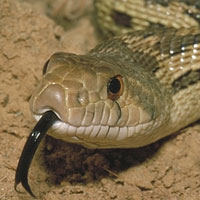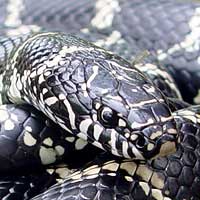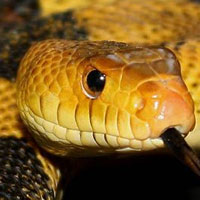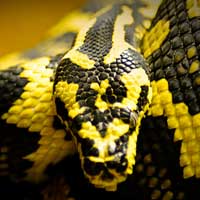Discover the Fascinating World of the New Guinea Small-eyed Snake
The New Guinea Small-eyed Snake (Micropechis ikaheka) belongs to the Elapidae snake family, which is known for its highly venomous species with fixed front fangs and potent neurotoxic venom, making it an efficient predator in its native habitats of New Guinea, surrounding islands, and parts of northern Australia, where it thrives in tropical forests, grasslands, and mangroves.
Scientific Name: Micropechis ikaheka
Snake Family: Elapidae
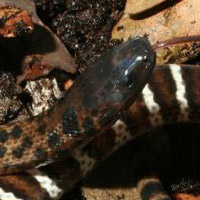
An Overview of the New Guinea Small-eyed Snake
The New Guinea Small-eyed Snake (Micropechis ikaheka) is a highly venomous species native to New Guinea and surrounding islands. This snake is recognized by its slender body, small eyes, and smooth scales, which help it blend seamlessly into its environment. Known for its potent venom and secretive nature, the New Guinea Small-eyed Snake plays a crucial role in regulating the populations of its prey, which includes small mammals and reptiles. Despite its venomous reputation, this elusive species rarely encounters humans, and its behavior is typically non-aggressive unless threatened.
Where Does the New Guinea Small-eyed Snake Live?
The New Guinea Small-eyed Snake occupies a variety of habitats across its geographic range. Key habitat features include:
- Geographic Range: Found throughout New Guinea, neighboring islands, and parts of northern Australia.
- Preferred Environments: Tropical rainforests, grasslands, and mangroves, as well as human-altered landscapes like plantations.
- Climate: Prefers warm, humid conditions characteristic of tropical and subtropical regions.
This snake is highly adaptable, often sheltering under logs, within leaf litter, or in burrows to avoid predators and extreme weather. It is also known to inhabit coastal areas and swamps, showcasing its resilience in diverse environments.
The table below provides a summary of its habitat preferences:
| Habitat Feature | Description |
|---|---|
| Geographic Range | New Guinea, surrounding islands, northern Australia |
| Preferred Terrain | Tropical forests, grasslands, mangroves |
| Climate | Warm and humid |
What Does the New Guinea Small-eyed Snake Eat?
The New Guinea Small-eyed Snake is a carnivorous predator that relies on its potent venom to subdue prey. Key dietary details include:
- Primary Prey: Small mammals such as rodents, and reptiles including lizards and snakes.
- Occasional Prey: Birds, amphibians, and eggs when other food sources are scarce.
- Hunting Strategy: Ambush predator that strikes quickly, delivering venom to immobilize prey before consumption.
Its diet varies based on availability, demonstrating its adaptability in diverse ecosystems. By preying on rodents and other small animals, this snake helps control populations that might otherwise disrupt local ecological balance.
Understanding the Behavior of the New Guinea Small-eyed Snake
The New Guinea Small-eyed Snake exhibits several unique behavioral traits that aid its survival in challenging environments. Key traits include:
- Activity Patterns: Nocturnal, active primarily at night to hunt and avoid predators.
- Defensive Behavior: Typically shy and secretive, but will strike if threatened or cornered.
- Social Behavior: Solitary, except during the mating season.
Despite its venomous capabilities, this snake is not aggressive and prefers to retreat if given the opportunity. Understanding its behavior is essential for avoiding conflict and appreciating its ecological role.
Health and Lifespan of the New Guinea Small-eyed Snake
The New Guinea Small-eyed Snake has a relatively long lifespan and is well-adapted to its environment. Important health considerations include:
- Lifespan: 10-15 years in the wild, with individuals in captivity often living longer under optimal care.
- Health Risks: Habitat loss, pollution, and predation are major threats.
- Predators: Birds of prey, larger reptiles, and carnivorous mammals.
Conservation efforts focused on habitat preservation and public education are crucial to ensuring the survival of this species.
How Does the New Guinea Small-eyed Snake Reproduce?
The reproductive cycle of the New Guinea Small-eyed Snake is closely tied to its environment. Key details include:
- Mating Season: Typically occurs during the wet season when resources are abundant.
- Reproductive Method: Oviparous, meaning females lay eggs that hatch outside the body.
- Clutch Size: Produces 5-15 eggs per clutch, depending on the female’s size and health.
- Hatchling Behavior: Young snakes are fully venomous and independent from birth, capable of hunting small prey immediately.
Successful reproduction depends on stable environmental conditions, emphasizing the importance of conserving its habitat.
Safety Guidelines for Handling the New Guinea Small-eyed Snake
Handling the New Guinea Small-eyed Snake requires caution and expertise. Essential safety tips include:
- Use professional tools like snake hooks and secure transport containers.
- Wear protective gloves and boots to minimize the risk of envenomation.
- Ensure enclosures are escape-proof and replicate the snake’s natural habitat.
- Keep antivenom readily available and have an emergency plan in place.
Only trained professionals should handle this species. Public education about its behavior and importance in the ecosystem can help reduce unnecessary fear and human-wildlife conflicts.
Disclaimer
The information provided in this article is for educational purposes only. SnakeEstate strongly advises against handling or interacting with venomous snakes, such as the New Guinea Small-eyed Snake, unless you are a trained and licensed professional. These snakes pose significant risks, and improper handling can result in serious injury or death. Always adhere to local regulations and prioritize safety when dealing with wildlife.
Other Snakes In This Species
 Asp Viper
Asp Viper Black Mamba
Black Mamba Boomslang
Boomslang Brazilian Coral Snake
Brazilian Coral Snake Bushmaster
Bushmaster Coastal Taipan
Coastal Taipan Common Death Adder
Common Death Adder Common European Adder
Common European Adder Copperhead
Copperhead Coral Snake
Coral Snake Cottonmouth
Cottonmouth Eastern Brown Snake
Eastern Brown Snake Eastern Diamondback Rattlesnake
Eastern Diamondback Rattlesnake Egyptian Cobra
Egyptian Cobra Fer-de-lance
Fer-de-lance Forest Cobra
Forest Cobra Indian Cobra
Indian Cobra Inland Taipan
Inland Taipan Jameson’s Mamba
Jameson’s Mamba King Cobra
King Cobra Lancehead
Lancehead Lataste’s Viper
Lataste’s Viper Malayan Krait
Malayan Krait Mojave Rattlesnake
Mojave Rattlesnake New Guinea Small-eyed Snake
New Guinea Small-eyed Snake Nose-horned Viper
Nose-horned Viper Puff Adder
Puff Adder Russell’s Viper
Russell’s Viper Saw-scaled Viper
Saw-scaled Viper Solomon Island Coral Snake
Solomon Island Coral Snake South American Rattlesnake
South American Rattlesnake Tiger Snake
Tiger Snake Western Diamondback Rattlesnake
Western Diamondback Rattlesnake



